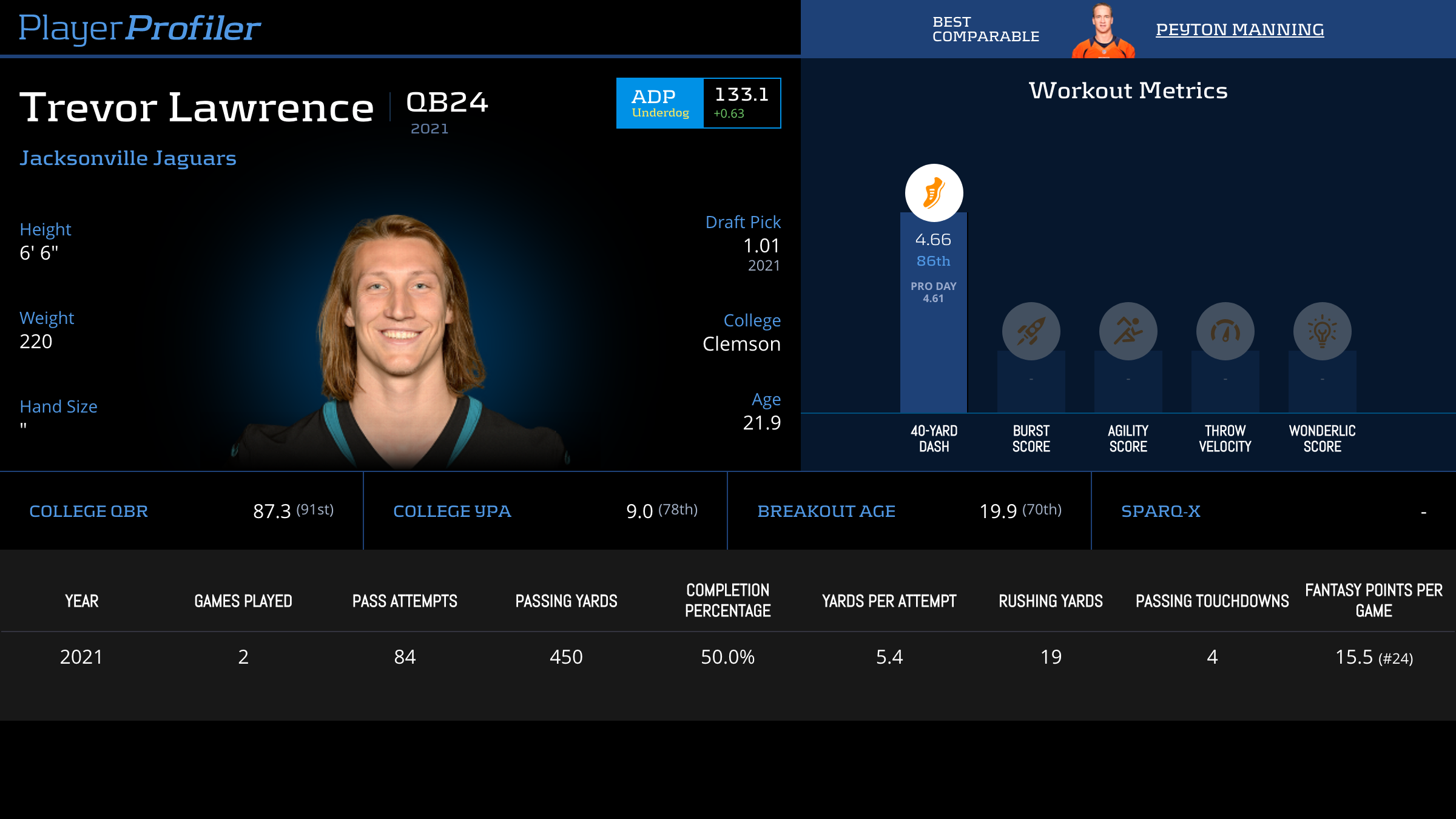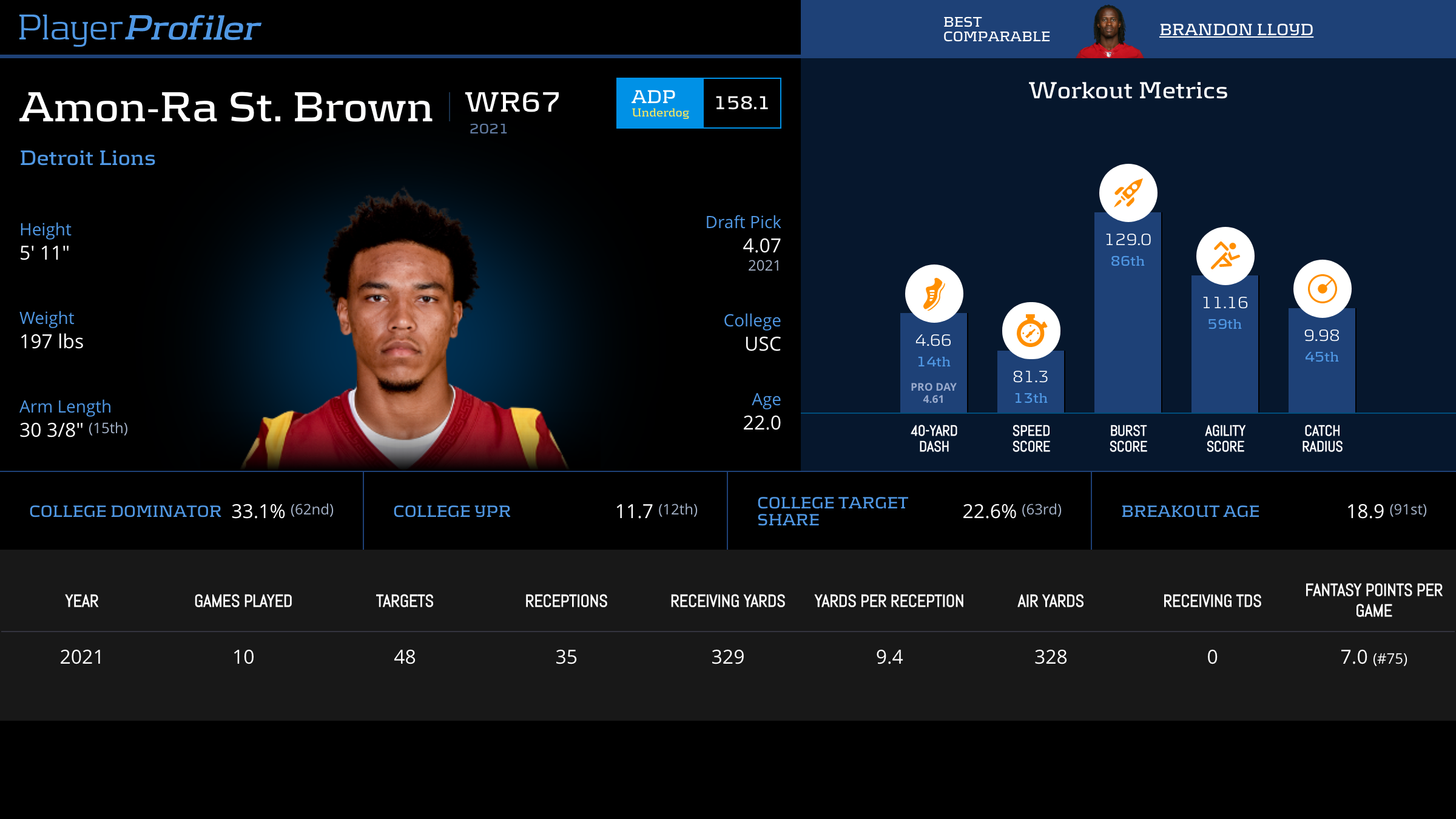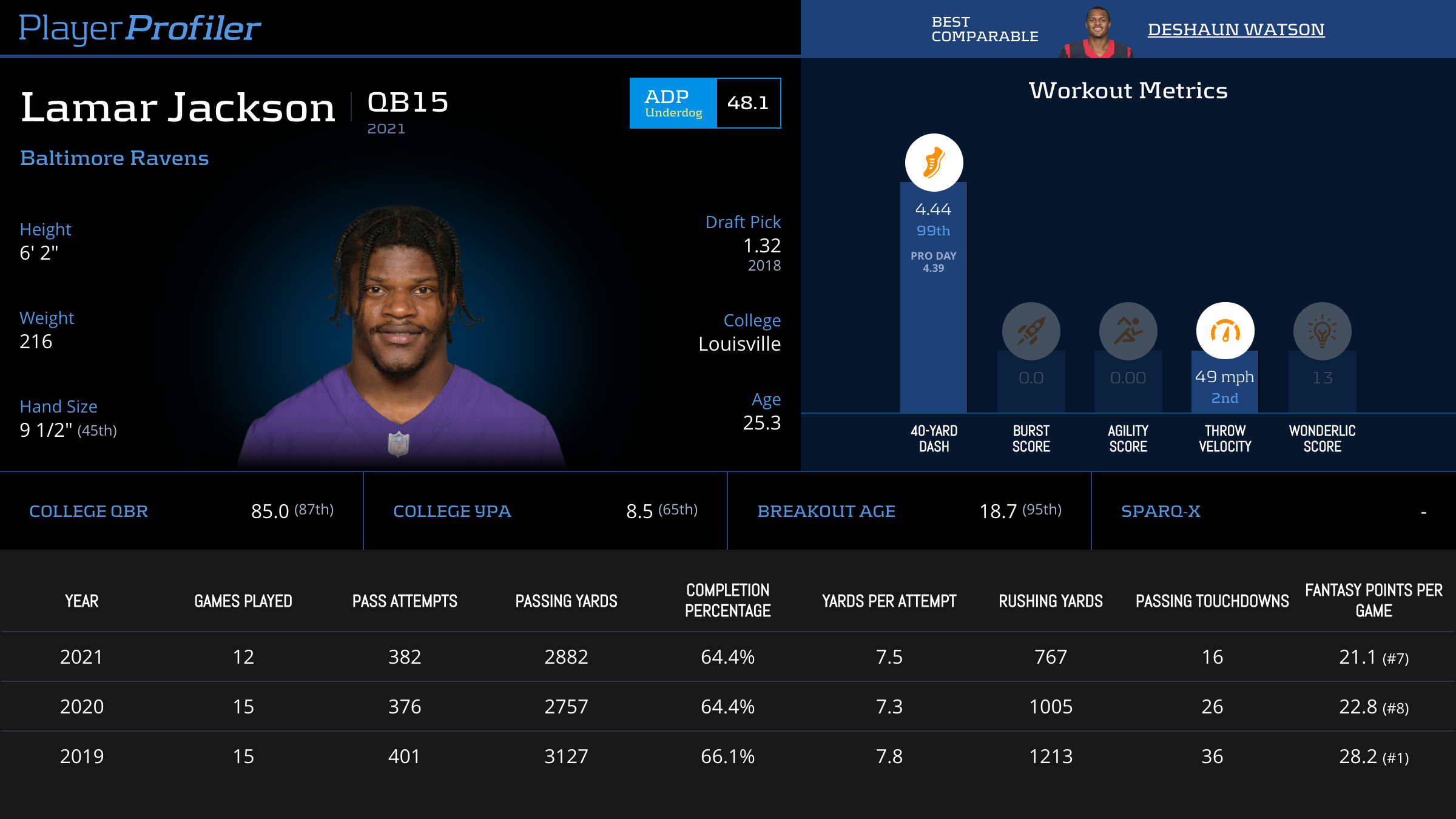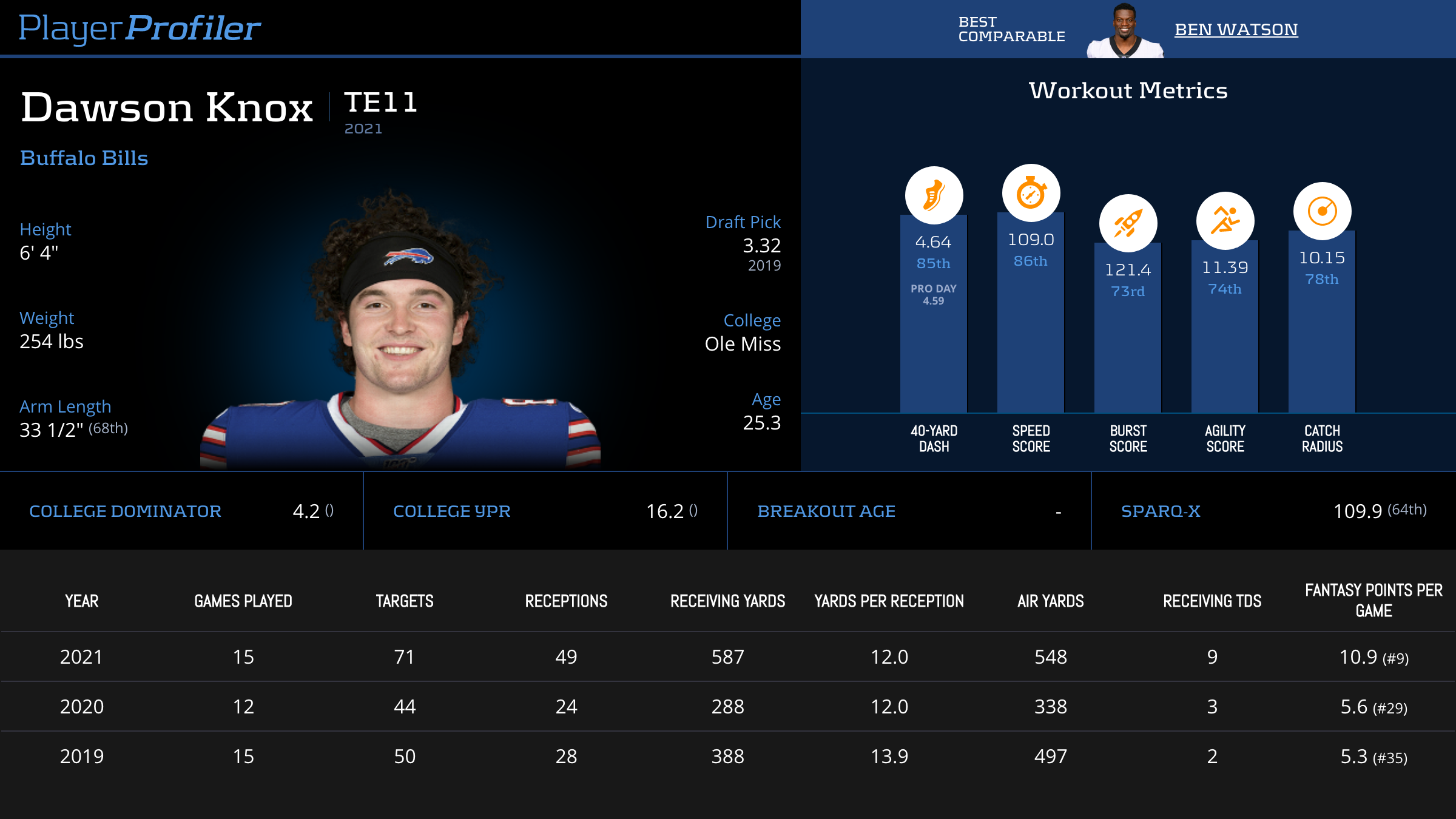In an earlier article, we set out to understand the structural differences between ADP in Underdog best ball drafts and FFWC high stakes drafts. Today, we take the next step and look at players whose ADPs differ from these trends and create opportunities for arbitrage between the two sites. Let’s start by summarizing the findings from Part 1.
In short, the shift from best ball leagues to high stakes redraft leagues leads to an increase in value for running backs and wide receivers and a corresponding decrease in value for quarterback and tight end. These are the “onesie” positions which require only one lineup spot every week. Intuitively this makes sense because these positions can be streamed in a redraft league, while conventional best ball strategy suggests teams should draft two to three players at each of QB and TE.
However, not all players align perfectly with these trends, and there is room for arbitrage across the two platforms. Certain players buck their positional trends entirely, and others vary within their position group. This creates value for us to target specifically on Underdog or FFWC. Let’s get right into it. Note: all ADP data is as of Thursday August, 25.
I’ll be referring to differences in ADP in terms of ADP Differential Percentage, which is a way of balancing out differences across the draft board. For example, a difference of five picks in ADP is much more valuable in Round 2 than Round 11. We’re able to reflect this by dividing the difference as a percentage of the overall pick value. As a reference point, the average ADP Differential percentage for each position is +32.2-percent for QB, +14.6-percent for TE, -4.4-percent for RB, and -11.0-percent for WR. A higher negative number indicates a higher ADP on FFWC and a higher positive percentage is a higher ADP on Underdog.
Better Values on Underdog:
QB: Trevor Lawrence
A generational prospect whose rookie year was doomed by Urban Meyer, Lawrence enters Year 2 with new weapons and a new system. While every quarterback’s FFWC ADP is lower than his Underdog ADP, Lawrence has the smallest gap in ADPs, with only a +15.5-percent ADP Differential. As a result, Lawrence is the QB15 on FFWC compared to the QB18 on Underdog.
In 2021, Lawrence finished with 12.7 PPR points per game, underperforming his Expected Fantasy Points of 17.5 by a drastic 4.8 PPR points per game. With Doug Pederson in town, positive regression from Lawrence is a strong bet that you can make at a much better value on Underdog. To pair with Lawrence, Christian Kirk is also a relative value on Underdog as WR37 on FFWC and WR40 on Underdog.
RB: Isiah Pacheco
The seventh round rookie out of Rutgers has been the talk of the preseason. He’s already leapfrogged Ronald Jones while making highlight reel catches in practice. His 98th percentile Speed Score and the high-value touches of the Kansas City backfield give Pacheco mouth watering upside if he finds regular season usage. Despite this, his Underdog ADP is lagging behind his FFWC ADP by almost 40 picks with an ADP Differential of -35.9-percent! Being drafted as the RB37 in high stakes and the RB47 on Underdog is a sure sign that you should be looking to get your Pacheco exposure on Underdog.
WR: Amon-Ra St. Brown
Amon St. Brown ended last season with a scorching hot streak that won managers fantasy championships. St. Brown broke Calvin Johnson‘s Lions record for consecutive eight-catch games with six such games to close the season. He finished as a top-10 PPR receiver in five of those six weeks and posted an unreal 35.6-percent target rate in that stretch as a rookie.
On FFWC, drafters are taking him as the WR21 at pick 41.0 on average. Underdog ADP sees him going as WR28 at pick 55.8. This results in an ADP Differential of -36.1-percent. This is well above the typical shift for wide receivers on FFWC. St. Brown is a glaring value on Underdog by this measure. Additionally, PlayerProfiler’s advanced metrics say his rookie season passed the test. St. Brown finished No. 20 in Route Win Rate and No. 30 in Formation-Adjusted Yards Per Route Run.
WR: Jakobi Meyers
Speaking of proven target-earning ability, Jakobi Meyers has demonstrated possessing it. Meyers has posted target rates of 26.4-percent and 25.9-percent in his last two seasons. The only factor that has kept him off many fantasy players’ radars is a lack of touchdowns with his only two career touchdowns coming last season. On FFWC, Meyers goes as the WR52 while he goes all the way down at WR65 on Underdog. This is good for an ADP Differential of -39.4-percent. Clearly, drafters on FFWC are more bullish, and for good reason, since we know touchdowns to be fluky. Meyers’ career rate of two touchdowns on 1,955 receiving yards is due for major regression.
TE: Dallas Goedert
In the first 100 picks, FFWC and Underdog have the same seven tight ends in the same order. As a result, Goedert comes up as a relatively subtle value on Underdog. All six of the other tight ends in the top 100 see a drop-off of at least eight picks from their Underdog ADP to their FFWC ADP with an average of 10.3. Goedert’s ADP only drops 1.9 picks from Underdog to FFWC, so we can safely say that FFWC drafters, on average, would consider Goedert the best value at TE on Underdog. Goedert has posted three straight seasons as a top-12 TE in PPR points per game. He will also finally be entering his first full campaign without Zach Ertz looming in the Eagles tight end room.
Better Values on FFWC:
QB: Lamar Jackson
Lamar Jackson has already demonstrated that he possesses the ability to put up the greatest fantasy quarterback season all-time. He’s the epitome of the rushing QB Konami Code. Jackson has led all quarterbacks in rushing attempts per game in all four of his seasons as a pro. You don’t need me to sell you on Jackson.
You’re here to find out that he’s going an egregious 40.1 picks later in ADP on FFWC than on Underdog for an ADP Differential of +45.5-percent. This presents a massive value on FFWC. This ADP Differential is highest among all quarterbacks, and we also see him go as QB4 on FFWC compared to QB3 on Underdog. Go get yourself some eighth round Jackson on FFWC and profit.
QB: Trey Lance
Look over here, it’s another high rushing upside quarterback available far later on FFWC than Underdog. Trey Lance‘s ADP Differential across sites is +41-percent. We see a drop from QB7 on Underdog to QB8 on FFWC. Despite indications this may be an up-and-down season for Lance, there is no denying that Kyle Shanahan is an elite coach at maximizing the talent of his players. Also consider Lance will be throwing to YAC monsters in Deebo Samuel, George Kittle, and Brandon Aiyuk. Lance should not be taking a greater hit in ADP Differential Percentage than later quarterbacks like Derek Carr and Justin Fields. If you miss out on Jackson in Round 8, you should be more than comfortable with Lance in ]Round 10 on FFWC.
RB: Derrick Henry
Henry will be 29 years old this season, he’s coming off of a major foot injury, and the Titans offensive line and offense overall have gotten worse. You likely won’t see me drafting much of Henry. However, ADP is ADP, and this exercise of ADP comparison tells us that Henry stands out as a value on FFWC. He goes as RB4 on Underdog at pick 7.8 overall, and he goes at RB7(!) on FFWC at pick 13.1. This checks in at the highest ADP Differential Percentage among running backs at +40.5-percent. Are we that sure that six other RBs should be going ahead of the King? If you’re even remotely a believer in Henry for 2022, be sure to head over to FFWC and get your exposure in the second round.
WR: Marquez Valdes-Scantling & Jerry Jeudy
As established in Part 1, wide receivers go drastically higher in ADP on FFWC than on Underdog. Valdes-Scantling and Jeudy are the only wide receivers in the top 200 picks who have an ADP Differential greater than +10-percent. This means they go markedly higher on Underdog than FFWC. When going from Underdog to FFWC, Jeudy drops from WR22 to WR29 with a +13.2-percent ADP Differential. Valdes-Scantling similarly goes from WR45 to WR56 with a +17.5-percent ADP Differential. I grouped them together here because they both find themselves in situations where drafters on Underdog are optimistic that they will thrive with their new quarterbacks, and that optimism has not translated to FFWC. As such, they are two upside bets that can be made more affordably at FFWC than they are currently going on Underdog.
TE: Dawson Knox
At tight end, the top five are all among the six biggest ADP Differentials. Due to the starting lineup depth of two flex spots, there is a greater need to spend picks in the first five rounds on RB and WR. The one tight not in the top five who is taking a hit similar to theirs on FFWC? Dawson Knox.
While he certainly ran hot on touchdowns last season, he’s still tied to the fantasy QB1 of the last two seasons, and the Bills have more questions behind Stefon Diggs than in years past. Knox falls from TE9 on Underdog to TE11 on FFWC with a +24.3-percent ADP Differential. Even though this may be partly explained by Underdog drafters chasing Josh Allen stacks, we shouldn’t forget that stacks are still valuable in managed seasonal leagues, and we should be targeting correlated upside bets in large field tournaments like the FFWC.
Regardless of your opinions on any one of these particular players, there is clear arbitrage to take advantage of by comparing ADPs across different sites. Be sure to get in some drafts and profit off of these inefficiencies!












